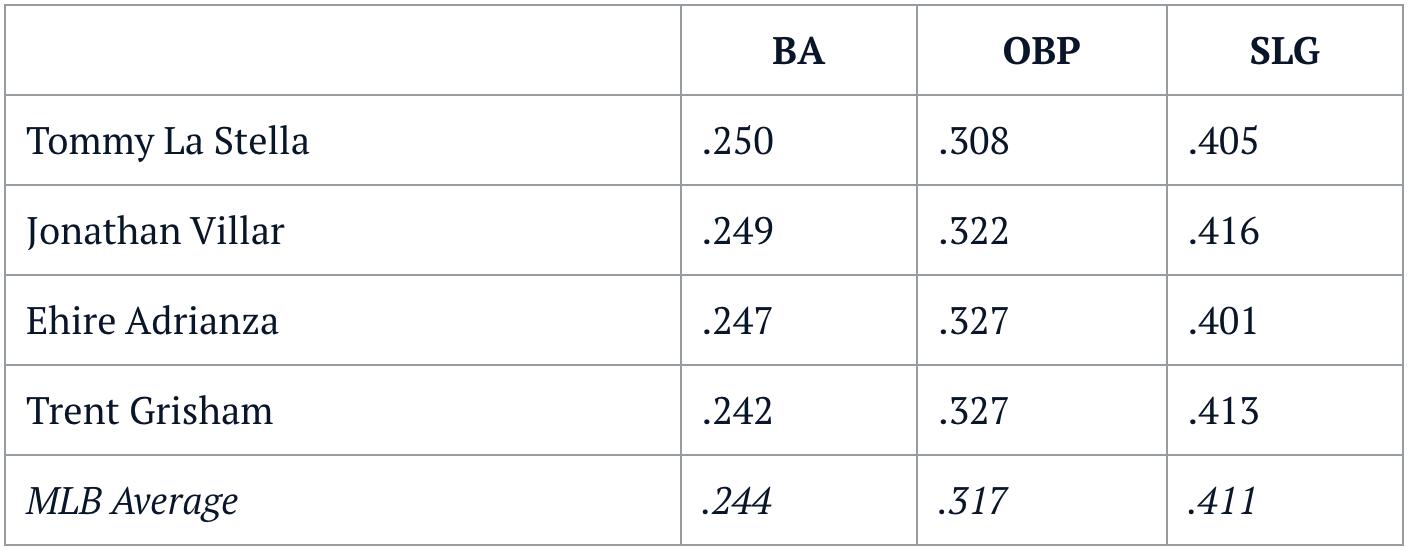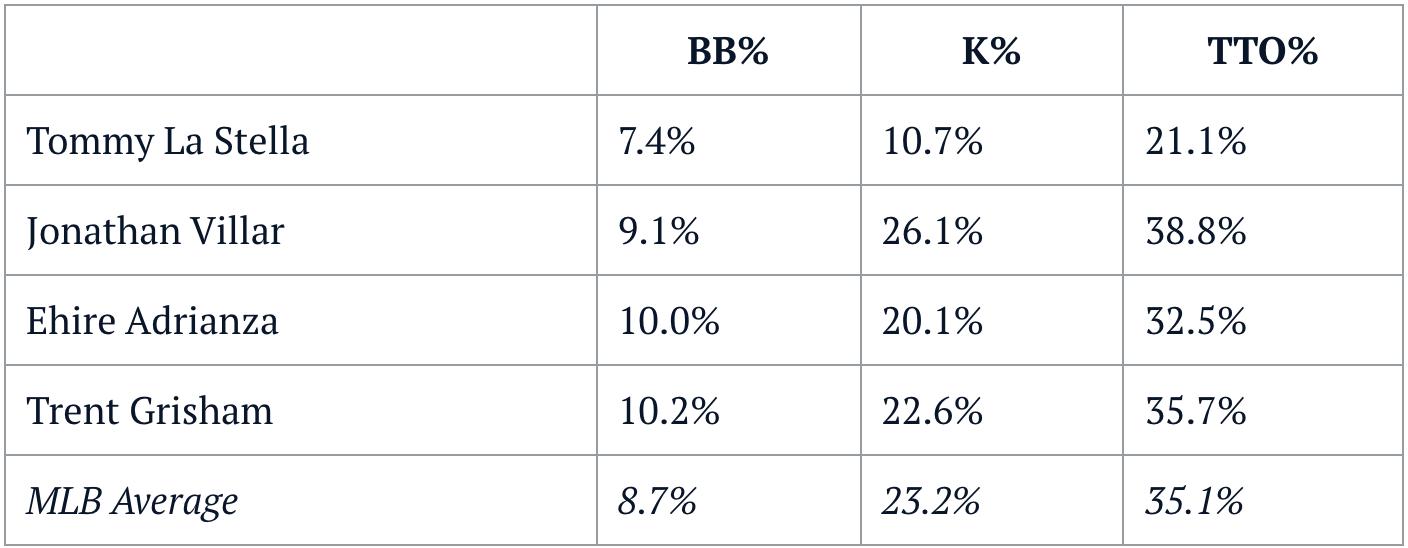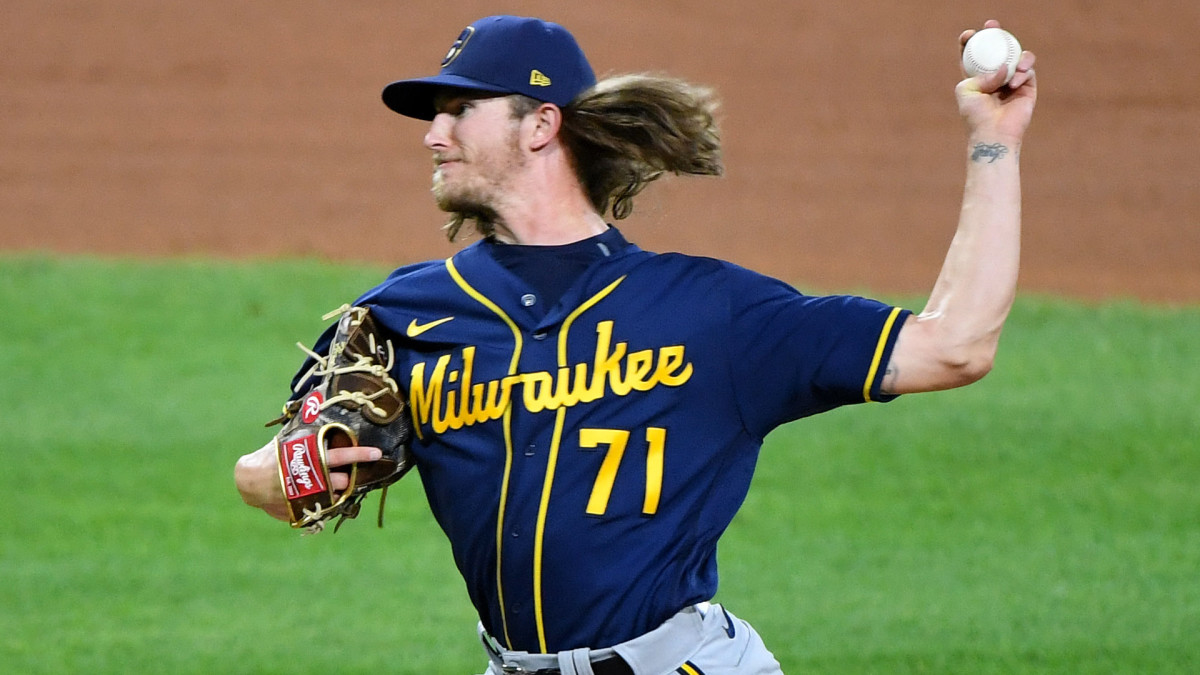Who Was MLB’s Most Representative Hitter in 2021?

Emma Baccellieri here, taking over for our usual newsletter author Matt Martell, who has enjoyed a much-deserved week off. And speaking of weeks off: We’ve all made it through the first full week of the off-season! Congratulations. But before we dive into a winter full of labor discussions, free-agency updates and other various and sundry dramas, I wanted to take one last look back at the season that was. Specifically, I wanted to dig into one question. … Which hitter best reflected what we saw across baseball this year?
It’s easy to find the hitter who was the most average. Sort an OPS+ leader board, find the players who were at exactly 100, and bam, you have the most average hitters. (A hearty congrats to Kyle Seager and Matt Chapman.) But there are lots of ways to have a 100 OPS+ and not all of them are necessarily reflective of what baseball actually looked like this year. The strikeout rate neared a record high. The batting average was the lowest it’s been in decades. The home run rate remained historically extreme. Who best captured that—not the most average hitter, but the most statistically representative, both in performance quality and in style?
We’ll start with the slash line. While other factors will be important, Mr. Representative will need to be in the same general ballpark as the 2021 marks for average, on-base percentage and slugging. Those MLB-wide numbers were .244/.317/.411. So let’s begin by looking for all the players who were close to all three numbers—10 points’ distance or less, in either direction, let’s say. We’ll also set a requirement that hitters must have had at least enough plate appearances to qualify for the batting title. That’s enough to give you a pretty small group! Here are the four players who fit the criteria:

It’s a good start. But to narrow the list further, it makes sense to turn to figures like strikeout and walk rates, plus one number that combines them: TTO%, or three-true-outcomes percentage, which measures what proportion of a player’s plate appearances ended in a walk, strikeout or home run. (MLB’s league-wide TTO% unsurprisingly set a record for a full season this year: 35.1%.) A slash line can give a general idea of all these; you can extrapolate home run rate from slugging and walk rate from the gap between average and on-base. But drilling down into the specifics is our best bet here:

That takes La Stella out of the running: To represent this year, you’re going to need more strikeouts and home runs. (C’mon, there’s no way a guy who struck out just once in 10 tries could possibly represent Major League Baseball in 2021.) Grisham would seem like the best fit—he has the smallest overall gap between the average figures in these three categories—but we can pull up one more set of figures to confirm. Here’s his batted-ball profile:

That’s pretty dead-on! The most obvious factor here was the TTO%. It’s hard to find a single figure that better captures the approach of a hitter, if not necessarily the quality, and it’s an area where Grisham almost exactly matched MLB. But just about everything else lined up, too. If you watched the Padres center fielder this year, you saw exactly what baseball was in 2021, for better and for worse.
Have any questions for our team? Send a note to mlb@si.com.
1. THE OPENER
“For three decades beginning in the 1930s, the Soil Conservation Service touted what it considered an ornamental plant to control soil erosion in the South. That plant, a vine known as kudzu, grew at the astounding rate of one foot every day. Kudzu grew out of control. It was a killer. It wiped out grasses, plants and trees by choking off their sunlight. Kudzu acquired another name: “the vine that ate the South.”
Relief pitching is baseball’s Kudzu. Its growth is overtaking the game.”
Thus begins Tom Verducci’s analysis of relief pitching’s role in the game today. (If botanical references aren’t enough to impress you, just read on, because an avant-garde musical composition reference pops up later.) Read the entire story here.
2. ICYMI
Ranking MLB’s Top 50 Free Agents by Will Laws and Nick Selbe
Need a primer on who’s available in free agency and where they might go? Will and Nick have got you covered.
3. WORTH NOTING from Emma Baccellieri

Josh Hader is now the first pitcher to win not two but three Reliever of the Year Awards. (The honor was announced Wednesday; Hader took home the NL’s prize while Liam Hendriks received the AL’s.) Hader previously won in 2018 and ‘19, and it’s hard to think of a better description of his recent work than “reliever of the year thrice in four years.” But here are a few choice statistics, anyway. In those four years, Hader has …
- ... struck out 46% of batters he faced. 46%! Almost half. (No one else was above 41%.)
- ... limited opponents to a batting average of .137. (No one else was below .165.)
- ... posted a WHIP of 0.83. (No one else was below 0.85.)
4. WHAT TO WATCH FOR from Emma Baccellieri
There shouldn’t be much free-agency activity to look out for this week. But there is one important deadline: Players who were extended a qualifying offer must respond to their teams by Wednesday. As a refresher, it’s a one-year offer that a team can make to its roster’s free-agents-to-be, set at the average of the top 125 salaries in MLB. The figure this year is $18.4 million. After last winter saw relatively few players receive the offer (six), this year there are 14.
Five players have already rejected it—Nick Castellanos, Michael Conforto, Corey Seager, Marcus Semien and Chris Taylor—and you can expect some more big names to follow. (Carlos Correa and Freddie Freeman can do a little better than the QO.) But there are a few other cases that are interesting. Chief among them? Noah Syndergaard. The Mets starter had surely once envisioned a much more auspicious start to his free agency than this. But after two seasons lost to injury, the smartest plan just might be to take the offer to stay in Queens, regroup for a season, and test free agency again next winter. That makes him the player likeliest to take the offer; other possibilities, albeit more distant ones, are Giants first baseman Brandon Belt and Angels closer Raisel Iglesias. Look out for their final calls by Wednesday.
5. THE CLOSER from, you guessed it, Emma Baccellieri
The general managers’ meetings took place this week in Carlsbad, Calif., which meant that baseball was treated to its annual round of Scott Boras Metaphors™. Some of this figurative language was a bit stretched. Some could fairly be described as bad. But all of it was memorable—and that’s exactly the point. Here’s a ranking of some of the most notable:
5. On Max Scherzer: “I think teams that are pursuing a championship are not pursuing the minimum. They’re taking it to the Max.” Grade: C-. It rolls off the tongue, but c’mon, we’ve all heard Max(imum) Scherzer puns before. We expect better from a quality wordplay master like Boras.
4. On Nick Castellanos: “I advised all of you two years ago that Ol' Saint Nick was going to bring a lot of presents to Cincinnati. Frankly, we're just going to sit back and see what teams have been naughty and nice.” Grade: B. Would have been easy to leave it at Ol’ Saint Nick, but tying it together with the “naughty and nice” bit puts it solidly above average.
3. On the Mets: “There's 29 teams that have their big carts out there and are filling them up. It may be the old adage, what's upsetting the Big Apple cart? It might be that it's rather unattended at the moment.” Grade: B+. Does the metaphor really make sense? Not as much as it should. But it’s a sick enough burn to pass muster anyway.
2. On Corey Seager: “Like a rock, and of course his parents knew this because they named him Corey.” Grade: A-. Get it? It’s Corey like quarry. That’s absolutely terrible! And yet … so bad it’s almost good.
1. On Kris Bryant: “He’s kind of the Sean Connery of baseball. He has positional versatility, which makes him untouchable. He has Bond-like abilities to create a great middle of the lineup. He’s always red-hot in the hunt for October. He’s an extraordinary gentleman and in a league of his own.” Grade: A+. That is not how The Hunt for Red October worked. (Sean Connery was the guy on Red October!) It’s somewhat confusing to break up The League of Extraordinary Gentlemen when there is, you know, an actual baseball movie called A League of Their Own. This whole thing is a mess. And it’s beautiful. A+.
That’s all from us today. We’ll be back in your inbox next Friday. As always, share this newsletter with your friends and family, and tell them to sign up at SI.com/newsletters. If you have any questions or comments, shoot us an email at mlb@si.com.
